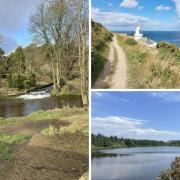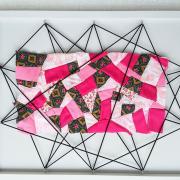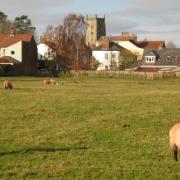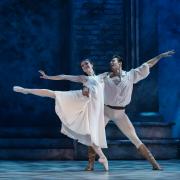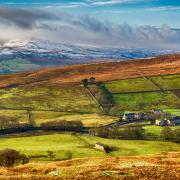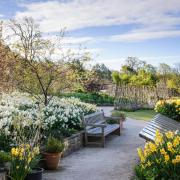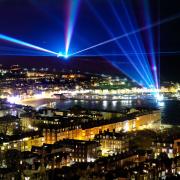Has Yorkshire Sculpture Park any plans to slow down as it enters its fifth decade? No chance, reports Jo Haywood

When you hit 40, you tend to take stock of your achievements, reassess your aims and make plans for the future. You might also drink yourself blind and dance yourself dizzy in a misguided attempt to recapture your lost youth (you’ll have to tie him up tighter if you don’t want him to escape), but these are not things that we at Yorkshire Life, purveyors of all things right and proper, would ever recommend.
Yorkshire Sculpture Park, which hit the milestone last summer, is very much of the taking stock, reassessing and making plans variety of forty-something, hitting the ground running with a major new development this year and a host of outstanding exhibitions.
But before we look forward, let’s look back, in the company of YSP founder and executive director Peter Murray.
‘The scale of what we wanted to achieve here was always ambitious,’ he said, as we chatted in his office at the Wakefield park on a beautiful bright winter morning. ‘But I could not have possibly foreseen what it was to become.

‘Even now, people still underestimate the scale of the operation. We have 160 or so people working across 500 acres, two lakes, three farms, an incredible but demanding landscape, a large catering outlet, 50,000 or so students coming through our education programme, a busy shop, multiple hugely complex displays and around half a million visitors a year expecting to see the biggest and the best exhibitions. Oh, and we have to look after a sculpture collection of international importance.’
It sounds exhausting, but Peter seems energised by the challenge, and more than ready to add to his workload in the coming months with the opening of a new visitor centre (more of that later) and a major new exhibition by world-renowned Italian artist Giuseppe Penone.
‘I’ve known him for 25 years,’ said Peter. ‘I met him at Dean Clough in Halifax and have been talking with him about exhibiting here at the park ever since. You have to be patient in this business. An exhibition will only happen when everyone is ready.’
Yorkshire was ready for a new adventure in sculpture in 1977 when Peter first launched the park at Bretton Hall, inspired by ‘our two local heroes’ Henry Moore and Barbara Hepworth. Their work came from the West Yorkshire landscape and is now very much part of it, sharing the space with creations by modern artists like Andy Goldsworthy, James Turrell and Sol LeWitt.

‘Most sculpture parks in the world started indoors and gradually moved outside,’ said Peter. ‘We started outdoors – out there in the landscape – and our indoor space came much later.
‘Very few galleries and museums have to deal with farmers and wandering flocks of sheep. We always have to take the wildlife into consideration and, of course, sustainability is key; not just in terms of the art, but the landscape too. They both play an equal role.’
It seems only right that the UK’s first sculpture park was developed in Yorkshire, widely regarded as the cradle of contemporary sculpture, but it wasn’t easy.
‘It took maybe five years for everything to fall into place,’ said Peter. ‘But it didn’t take long for us to understand the full potential. It’s what this landscape was crying out for. It’s such a subtle and complex landscape, providing interesting open spaces and more intimate areas that create different moods. The landscape creates its own galleries and trails.’

Galleries and trails that Clare Lilley has to populate with art as part of her role as director of programme. She joined the team 26 years ago – ‘the soil gets into your blood and you feel rooted to this rather wonderful landscape’ – and has seen it grow and develop into an international touchstone for contemporary art.
‘This place has been part of the cultural landscape for two generations now,’ she said. ‘The relationship between visitors – especially Yorkshire visitors – and the park is very strong; there’s a real sense of sanctuary for people, of a safe place to explore art and to explore their own thoughts.
‘Without an audience, we all might as well go home. Our art doesn’t mean anything if no one can see it. Access is everything. We want people to be able to look at and experience our art without feeling inhibited; to experience it on their own terms.’
Among the highlights of her meticulously planned (and hair-raisingly packed) 2018 programme are Giuseppe Penone (May 26th to January 6th), whose work includes Matrice, a 30m-long piece that will span the entire length of the Underground Gallery, passing though specially formed apertures in the walls; acclaimed installation and performance artist Chiharu Shiota, who will be transforming the Chapel (March 30th to June 3rd) with 2,000 balls of white thread woven in the air to reflect the music and light of the space; and Thukral and Tagra, who will be inviting families, friends and strangers to gather in the new Bretton Country Park Gallery this summer to play a game that encourages deep discussion of important world issues.
The gallery is part of the new visitor centre development, which is due for completion in late summer, opening up a further 100 acres as well as providing a second restaurant and information centre.
‘The park is not a place that stands still,’ said Clare. ‘When I arrived we only had 15 acres, now we have 500. This place is organic by nature; you can feel it’s rooted in the earth on which it stands. In this way, it will never stagnate. It will always grow.’
It can only do this, however, if the money keeps on coming in, which is not easy when public arts funding consistently declines. Thankfully, Yorkshire Sculpture Park actually makes money – something of an anomaly in the world of galleries and museums.
‘We can never take this for granted though,’ said Peter. ‘We have to constantly search for new projects to boost our income stream. The new visitor centre is one of these projects. It will encourage visitors to spread out and enjoy the landscape from a different perspective and, hopefully, increase the spend per person.’
As it enters its fifth decade, Yorkshire Sculpture Park is still full of youthful enthusiasm. It might be experiencing a little middle-aged spread but, in this case, that can only be a good thing, as more space means more art.
‘My central philosophy has always been – and always will be – to make art accessible,’ said Peter. ‘Remember what it was like before we started. There was no Henry Moore Institute and The Hepworth did not exist. Even the Tate was quite small back then. We have been instrumental in the expansion of contemporary art in this country. It might sound terribly immodest but, without us, I’m not sure the others would be where they are now.
‘But that doesn’t mean we can afford to sit back and simply enjoy our success. The landscape never stands still, it’s always moving, developing and changing. We have to do the same.’






